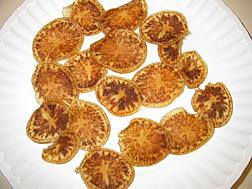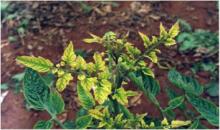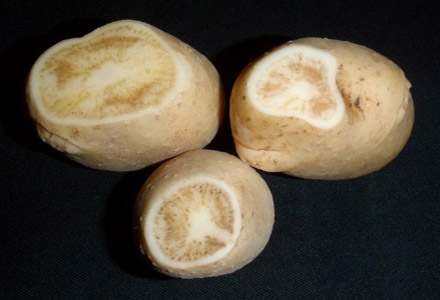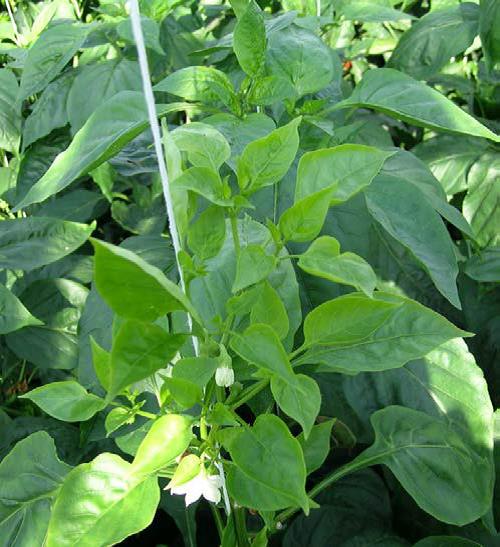
Candidatus Liberibacter solanacearum






Candidatus Liberibacter solanacearum is a bacterium which infects capsicums, carrots, celery, parsley, potatoes and tomatoes. It causes significant yield reductions and renders French fries or potato crisps unmarketable (Figure 1).
Current situation
Candidatus Liberibacter solanacearum was detected in imported parsley seed in 2017. Haplotypes D and E were detected in seed imported into Australia from Italy and Germany. These haplotypes are different to the haplotypes that are vectored by tomato-potato psyllid and cause the plant disease zebra chip in potatoes.
The detection occurred in an imported commodity and therefore the bacterium is not currently considered present in Australia.
Notifiable status
Candidatus Liberibacter solanacearum is a notifiable plant disease in NSW.
All notifiable plant pests and diseases must be reported within 1 working day. You can report notifiable plant pests and diseases by one of the following methods:
- Call the Exotic Plant Pest Hotline 1800 084 881
- Email biosecurity@dpi.nsw.gov.au with a clear photo and your contact details
- Complete an online form
A full list of notifiable plant pests and diseases can be found in Schedule 2 of the NSW Biosecurity Act 2015.
Description
Early signs of Candidatus Liberibacter solanacearum infection are leaf curling and purpling in host plants (Figure 2). Leaf yellowing and chlorosis are later symptoms (Figure 3).
General plant disease symptoms include plant stunting, erectness of new foliage, upward leaf curling, leaf purpling and chlorosis, shortened and swollen terminal internodes resulting in leaf rosettes, enlarged nodes, axillary branches or aerial tubers and many small, misshapen fruit.
Infected potatoes also have collapsed stolons and tubers with enlarged lenticels, vascular tissue browning, necrotic flecking and medullary ray streaking (Figure 4).
Infected tomatoes show stunting, leaf curling, leaf chlorosis or mottling and have deformed fruit.
Infected capsicums display plant stunting, leaf curling, pale green or chlorotic leaves, sharply tapered leaves, shortened leaf internodes and flower abortion (Figure 5).
Infected carrots have leaf curling, bronze, purplish or yellowish leaves, stunted main roots and shoots and a proliferation of side roots (Figure 6).
Infected celery has an abnormal proliferation of shoots, stem curling and yellowing.
Damage
Candidatus Liberibacter solanacearum causes seedling blight, dwarfing, wilt, dieback and early plant death. It significantly lowers crop yields.
Potato yields are reduced by 43-93%. Symptomless tubers produced when potato plants are infected late in the growing season can develop internal disease symptoms during storage. Infected potato tubers won’t sprout or only grow weak plants when sown. Carrots can suffer 100% yield losses.
Candidatus Liberibacter solanacearum causes higher sugar concentrations in potato tubers. When infected potato tubers are fried they caramelise and burn, creating highly visible dark and bitter tasting French fries and potato crisps. This makes infected potato tubers unmarketable.
Psyllid insects, which spread the bacteria by feeding on plant sap, can also damage host plants as they feed. The psyllids have piercing needle-like sucking mouth parts.
When feeding on potatoes, tomato potato psyllids inject toxins in their saliva, which causes leaf purpling or yellowing and results in smaller, fewer or misshapen potato tubers.
Candidatus Liberibacter solanacearum bacteria can infect host plants at all growth stages – seed, seedling, vegetative, flowering and fruiting.
It takes one to two months after inoculation by infected psyllids to produce disease symptoms in host plants.
Plant disease symptoms are not constant over time or between sites. They may vary with the seasons, host plants, haplotypes or environmental conditions.
Potatoes and tomatoes are the most severely infected plant hosts, capsicums and eggplants show less severe symptoms, while carrots, Cape gooseberry, celery, parsley, tamarillo and thornapple can be symptomless hosts.
Symptom severity also varies between varieties in host crops.
Haplotypes | Insect Hosts | Plant Hosts | Distribution |
|---|---|---|---|
Haplotype A | Bactericera cockerelli | Solanaceae family (capsicum, potato & tomato) | Central & North America, New Zealand |
Haplotype B | Bactericera cockerelli | Solanaceae family (capsicum, potato & tomato) | Central & North America |
Haplotype C | Trioza apicalis | Apiaceae family (carrot) | Finland, Germany, Norway, Sweden |
Haplotype D | Bactericera trigonica | Apiaceae family (carrot & parsley) | Spain, Morocco, United Kingdom |
Haplotype E | Bactericera trigonica | Apiaceae family (carrot, celery & parsley) | France, Spain, Morocco, United Kingdom |
Lifecycle
Candidatus Liberibacter solanacearum bacteria move inside the phloem tissue of host plants. By living and multiplying in phloem tissue they avoid the plant’s natural defences against pathogens. When phloem-feeding psyllid insects feed on plant sap in the phloem tissue, the bacteria are also eaten.
The bacteria multiply in the psyllid host. They move from the psyllid’s gut to its salivary glands, where they can infect host plants when the psyllids feed. Psyllids become infectious within three days of ingesting the bacteria. Once the psyllids acquire the bacteria, they remain carriers for life.
The Candidatus Liberibacter solanacearum lifecycle alternates between plant and insect hosts. The bacteria are obligate parasites and can only multiply inside host plants and psyllids. The prefix “Candidatus” is used in the bacterium’s name as it can’t be cultured outside its natural hosts. The optimum temperature for disease development in potatoes is 27-32°C. The bacteria are heat-sensitive and don’t seem to tolerate temperatures over 32°C.
Host range
Candidatus Liberibacter solanacearum bacteria are grouped into five gene groups or haplotypes. Each haplotype infects different vegetable crops. Haplotypes A and B infect Solanaceous plant family members like capsicum, potato and tomato, while haplotypes C, D and E infect Apiaceous plant family crops such as carrot, celery and parsley (Table 1). Haplotype E can also infect potatoes.
Candidatus Liberibacter solanacearum host crops include Cape gooseberry (Physalis peruviana), capsicum (Capsicum annuum), carrot (Daucus carota subsp. sativus), celery (Apium graveolens), goji berry (Lycium barbarum), eggplant (Solanum melongena), parsnip (Pastinaca sativa), parsley (Petroselinum crispum), potato (Solanum tuberosum), tamarillo (Solanum betaceum), tobacco (Nicotiana tabacum), tomatillo (Physalis philadelphica) and tomato (Solanum lycopersicum).
Solanaceous weeds such as bittersweet nightshade (Solanum dulcamara), black nightshade (Solanum ptychanthum), Jerusalem cherry (Solanum pseudocapsicum), silverleaf nightshade (Solanum elaeagnifolium) and thornapple (Datura stramonium) can host Candidatus Liberibacter solanacearum bacteria.
Spread
Candidatus Liberibacter solanacearum is primarily spread by insects. Haplotypes A and B are transmitted by the tomato potato psyllid (Bactericera cockerelli), haplotype C is spread by the carrot psyllid (Trioza apicalis) and haplotypes D and E are transmitted by the Bactericera trigonica psyllid.
Tomato potato psyllid spreads Candidatus Liberibacter solanacearum by feeding on infected plants or via intergenerational trans-mission of the bacteria through its offspring.
Infected psyllids can fly between host plants or be moved as eggs, nymphs or adults on plant material. They are also dispersed by aircraft, shipping containers, farm machinery and vehicles.
Haplotypes A and B are also spread by infected seed potatoes. Haplotypes D and E are spread by infected carrot, parsley and parsnip seed or infected carrot, celery and parsnip tissue cultures. All haplotypes are transmitted from infected plants by plant grafting and vegetative propagation.
Distribution
Candidatus Liberibacter solanacearum was first found in potatoes in Mexico and Central America in the 1990’s. Haplotypes A and B were spread to Solanaceous crops in the United States and New Zealand by tomato potato psyllids.
Candidatus Liberibacter solanacearum was first found in carrots in Finland in 2010. Haplotypes C, D and E have been detected in carrots in Finland, France, Germany, Morocco, Norway, Spain and Sweden, celery in Spain, parsley in the United Kingdom and parsnips and potatoes in Spain.
Tomato potato psyllid (TPP) is found in Central and North America, Australia and New Zealand. The carrot psyllid lives in northern Europe, while the Bactericera trigonica psyllid inhabits the Mediterranean regions. Carrot psyllid lives in temperate and sub-arctic climates, while TPP and Bactericera trigonica psyllids live in the temperate and sub-tropical climate zones.
Control measures
To stop Candidatus Liberibacter solanacearum spreading, the following measures may be used:
- only sow potato or vegetable seed that is certified 100% free of Candidatus Liberibacter solanacearum
- only buy transplants and rootstocks grown from vegetable seed that is certified 100% free of Candidatus Liberibacter solanacearum
- monitor host crops with sticky traps to detect psyllid insects
- remove host weeds from crops and adjacent areas to reduce psyllid infestation
- control psyllids in crops and adjacent areas to reduce disease transmission
Actions to minimise risks
Put in place biosecurity best practice actions to prevent entry, establishment and spread of pests and diseases:
- practice “Come clean, Go clean”
- ensure all staff and visitors are instructed in and adhere to your business management hygiene requirements
- source propagation material of a known high health status from reputable suppliers
- monitor your crop regularly
- keep records

